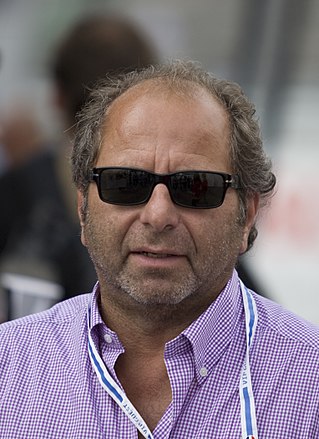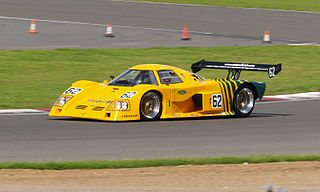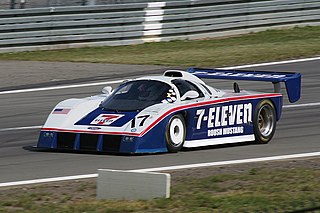Related Research Articles

Robert Woodward Rahal is an American former auto racing driver and current team owner of Rahal Letterman Lanigan Racing. As a driver he won three championships and 24 races in the CART open-wheel series, including the 1986 Indianapolis 500. He also won the Indianapolis 500 in 2004 and 2020 as team owner for Buddy Rice and Takuma Sato, respectively.

The DFV is an internal combustion engine that was originally produced by Cosworth for Formula One motor racing. The name is an abbreviation of Double Four Valve, the engine being a V8 development of the earlier four-cylinder FVA, which had four valves per cylinder.

Zakspeed is a motor racing team from Germany, founded in 1968 by Erich Zakowski and then run by his son Peter Zakowski. It is based in Niederzissen, Rhineland-Palatinate, around 25 kilometres (16 mi) from the Nürburgring circuit.

All American Racers is an American-licensed auto racing team and constructor based in Santa Ana, California. Founded by Dan Gurney and Carroll Shelby in 1964, All American Racers initially participated in American sports car and Champ Car races as well as international Formula One events with cars named Eagle. The Formula One team, based in the United Kingdom and using British-built Weslake engines was named Anglo American Racers. Under team manager Bill Dunne they set up shop in Rye, East Sussex. The team were adjacent to Harry Weslake's engine development plant and half a mile from Elva cars. They participated in 25 Grands Prix, entering a total of 34 cars.

Judd is a brand of racing car engines built by Engine Developments Ltd., a company founded in 1971 by John Judd and Jack Brabham in Rugby, Warwickshire, England. Engine Developments was intended to build engines for Brabham's racing efforts, and became one of the first firms authorised by Cosworth to maintain and rebuild its DFV engines, but has since expanded into various areas of motorsport.

Klaus Karl Ludwig is a German racing driver.

The BMW M12/13 turbo was a 1,499.8 cc four-cylinder turbocharged Formula One engine, based on the standard BMW M10 engine introduced in 1961, and powered the F1 cars of Brabham, Arrows and Benetton. Nelson Piquet won the FIA Formula One Drivers' Championship in 1983 driving a Brabham powered by the BMW M12/13 turbo. It was the first Drivers' Championship to be won using a turbocharged engine. The engine also powered the BMW GTP and in the 2.0-litre naturally-aspirated form, the successful March Engineering Formula Two cars. BMW engineers estimated the engine produced around 1,400 hp at maximum boost, however the BMW engine dynamometer could not go beyond 1,280 bhp.
The 1981 World Sportscar Championship season was the 29th season of FIA World Sportscar Championship motor racing. It featured the 1981 FIA World Endurance Championship which was contested over a fifteen race series which ran from 31 January to 27 September. The former World Challenge for Endurance Drivers was renamed to the World Endurance Championship of Drivers for 1981 and the World Championship of Makes was renamed to the World Endurance Championship of Makes. Bob Garretson won the World Endurance Championship of Drivers and Lancia was awarded the World Endurance Championship of Makes.

The Nissan NPT-90 was a racing car developed in 1990 for Nissan Motors by Nissan Performance Technology Incorporated (NPTI), formerly known as Electramotive Engineering. It was a replacement for the highly successful GTP ZX-Turbo that had won the IMSA GT Championship in 1989. The NPT-90 would go on to win the championship in 1990 and 1991 before being retired by Nissan at the end of the 1992 season.

The 1984 Sandown 1000 was an endurance motor race staged at the Sandown Raceway in Victoria, Australia on 2 December 1984. It was the eleventh and final round of the 1984 FIA World Endurance Championship and was the first FIA World Championship race to be held in Australia. It was to be the first of a three-year contract to race at Sandown, though the final two years would be cancelled.

John Marshall Watson, is a British former racing driver and current commentator from Northern Ireland. He competed in Formula One, winning five Grands Prix and was third in the 1982 championship. He also competed in the World Sportscar Championship finishing second in the 1987 championship. After his retirement from motorsport, he became a commentator for Eurosport's coverage of Formula One from 1989 to 1996. He currently commentates on the GT World Challenge Europe and commentated on the 2022 Miami F1 Grand Prix for F1TV.
The Lola T616 is a sports prototype built by Lola Cars to the Group C2 and IMSA GTP regulations. It was built with the intention to compete in the IMSA GT Championship and the World Sportscar Championship, and became the second Mazda-powered prototype to score a class win at the 24 Hours of Le Mans after the 717C triumphed in the same C2 class at the 1983 24 Hours of Le Mans.

The Intrepid RM-1 is a sports prototype racing car designed in 1991 by Bob and Bill Riley and built by Pratt & Miller to IMSA GTP specifications. Powered by a Chevrolet V8 engine, it was campaigned variously by Jim Miller, Prototype Technology Group and Wayne Taylor in the IMSA Camel GT from 1991 through 1993. Though it won only one race in its three seasons of competition, the shovel-nosed Intrepid was notable for the extreme—and at one point, disastrous—levels of downforce it generated, giving it the highest cornering speeds of any prototype of its era. The car's development was set back by a devastating 1991 crash at Watkins Glen that critically injured driver Tommy Kendall, and the program never fully recovered.

The Ford C100 is a sports racing car, initially built and run as a Group 6 car, but later as a Group C car. The C100 was built by Ford in 1981, and initially featured a 4-litre Cosworth DFL V8 engine, which was replaced by a 3.3-litre version of the same engine in 1983, after the car had passed to private hands. Five cars are known to have been built. Although the cars were often very quick in qualifying, reliability problems plagued them, and restricted their successes to two Deutsche Rennsport Meisterschaft victories in 1982, and a single Thundersports victory in 1983.

The Ford Mustang Maxum GTP was an IMSA GTP sports racing car designed by Paul Brown and constructed by Maxum Sports Cars. It was operated by Roush Racing during the 1987 season.

The BMW GTP was an IMSA GTP sports racing car built by BMW in 1986. Four March 86Gs were rebuilt by BMW North America into the BMW GTP, and fitted with a Formula One-derived BMW M12/14 turbocharged straight-four engine. Like the F1 cars that used the M12 engine, the BMW GTPs were fragile, and often retired from races; however, when they did complete a race, the BMW GTP was usually classified in the overall top ten. For longevity purposes in endurance races, it usually ran around 800 hp. However, in qualifying trim, 1,400 hp was feasible; combined with the aerodynamics the 220+mph top speed was limited only by gearing.

The Zerex Special was a sports racing car. Originally a Cooper T53 built for the 1961 United States Grand Prix, it was rebuilt for usage in American sports car racing, and featured open-top bodywork. Initially using a 2.75-litre version of the Coventry Climax FPF straight-four engine, it later used a Traco-Oldsmobile 3.5-litre V8. The car won numerous races throughout its four-year career, being driven by drivers such as McLaren and Roger Penske.
The Mazda GTP is an IMSA GTP race car that was built by Pierre Honegger in 1981. Based on a Mazda RX-7, the car initially competed in the GTX category as the Mazda RX-7 GTP, before it was rebuilt for the IMSA GTP category in 1983. Throughout its career, the car used a Mazda 13B Wankel rotary engine, similar to that used in the production RX-7s. Although the rotary-engined sports prototypes generally had a reputation of being very reliable, the Mazda GTP frequently failed to finish races, and was never able to better the eighth place achieved at the 1983 24 Hours of Daytona. In 1986, one car was purchased by Erie Scientific Racing, and rebuilt to become the Badger BB. This car was no more successful or reliable than its predecessor, and was last used in 1989, by which point it was owned by Jack Engelhardt. The other car, meanwhile, was rebuilt by Honegger into the Denali Speedcar, which was used with moderate success in 1986 and 1987.

The March 86G was a Group C and IMSA GTP sports racing car built by March Engineering. Built as simply a chassis with no engine, it was branded as one of three cars, the BMW GTP, the Buick Hawk or the Nissan R86V depending on which engine was placed in the chassis and which team was running it. There were a number of subtle bodywork changes to reflect the manufacturer which ran the car.
The Ford Probe GTP, also sometimes called the Ford Mustang Probe GTP, was an IMSA GTP sports racing car, designed, developed and built by German constructor Zakspeed, and used by the Zakspeed Racing team in the 1985 IMSA GT Championship. It was based on the standard road-going Ford Probe, and was the successor to the Ford Mustang GTP race car.. Unlike the road car, using a conventional front-engined designed, the prototype race car used a mid-engined design. It was powered by a 2.1 L (130 cu in) engine that was based off the Zakspeed 1500, as used in Zakspeed's Formula 1 cars. The 2.1 litre engine that was used in the Ford Probe GTP is often confused with the Ford Lima based engine that was used in the Ford Mustang GTP and the 2.1 litre variants of the Cosworth BDA engine. In Endurance racing trim it produced 600 hp (450 kW), which was plenty powerful enough for the lightweight 1,770 lb (800 kg) vehicle. This drove the rear wheels through a five-speed Hewland VG5 manual transmission. Klaus Ludwig, Doc Bundy, Lyn St. James, Scott Pruett, Pete Halsmer, Arie Luyendyk, Tom Gloy, and Chip Robinson all drove the car. Highlights for the car included two second-place podium finishes at Watkins Glen and Sears Point in 1985, and an outright win for Klaus Ludwig at Laguna Seca in 1986.
References
- 1 2 3 "1983 Ford Mustang GTP". Supercars.net. Retrieved 21 September 2013.
- 1 2 3 4 5 6 7 "Ford Mustang GTP". IMSA History. Archived from the original on 21 September 2013. Retrieved 21 September 2013.
- ↑ Wagenblatt, Bill (March 7, 2010). "IMSA Ford Mustang GTP". Track Thoughts. Archived from the original on September 25, 2013. Retrieved September 21, 2013.
- ↑ The 84-86 Ford Zakspeed Mustang GTP Turbo. The cars the whole world thinks have the wrong engine... , retrieved 2023-11-01
- ↑ "Meet the Fox-Body Mustang's Long-Forgotten, Race-Bred Sibling, the Wild GTP". 15 May 2022. Retrieved 17 June 2022.
- 1 2 "Road America 500 Miles 1983 – Photo Gallery". Racing Sports Cars. Retrieved 21 September 2013.
- ↑ "Road America 500 Miles 1983 – Race Results". Racing Sports Cars. Retrieved 21 September 2013.
- ↑ "Pocono 500 Miles 1983 – Race Results". Racing Sports Cars. Retrieved 21 September 2013.
- ↑ "Daytona Finale 3 Hours 1983 – Race Results". Racing Sports Cars. Retrieved 21 September 2013.
- ↑ "IMSA Camel GTP Championship 1983". Driver Database. Retrieved 21 September 2013.
- ↑ "Miami 3 Hours 1984 – Race Results". Racing Sports Cars. Retrieved 21 September 2013.
- ↑ "Road Atlanta 500 Kilometres 1984 – Race Results". Racing Sports Cars. Retrieved 21 September 2013.
- ↑ "Riverside 6 Hours 1984 – Race Results". Racing Sports Cars. Retrieved 21 September 2013.
- 1 2 "Laguna Seca 100 Miles 1984 – Race Results". Racing Sports Cars. Retrieved 21 September 2013.
- ↑ "Charlotte 500 Kilometres 1984 – Race Results". Racing Sports Cars. Retrieved 21 September 2013.
- ↑ "Watkins Glen 6 Hours 1984 – Race Results". Racing Sports Cars. Retrieved 21 September 2013.
- ↑ "Portland 3 Hours 1984 – Race Results". Racing Sports Cars. Retrieved 21 September 2013.
- ↑ "Sears Point 100 Miles 1984 – Race Results". Racing Sports Cars. Retrieved 21 September 2013.
- ↑ "Road America 500 Miles 1984 – Race Results". Racing Sports Cars. Retrieved 21 September 2013.
- ↑ "Michigan 500 Kilometres 1984 – Race Results". Racing Sports Cars. Retrieved 21 September 2013.
- ↑ "Daytona Finale 3 Hours 1984 – Race Results". Racing Sports Cars. Retrieved 21 September 2013.
- ↑ "IMSA Camel GTP Championship 1984". Driver Database. Retrieved 21 September 2013.